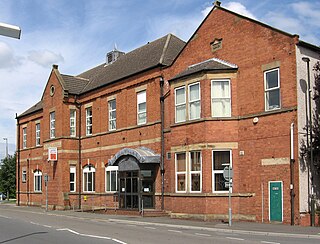Related Research Articles

Staveley is a former mining town in the borough of Chesterfield, Derbyshire, England, alongside the River Rother, between Eckington to the north, Barlborough to the east, Sutton cum Duckmanton to the south and Brimington to the west.

Maltby is a former mining town and civil parish of 16,688 inhabitants (2011) in the Metropolitan Borough of Rotherham, South Yorkshire, England. It was historically in the West Riding of Yorkshire. It is located about 6 miles (10 km) east of Rotherham town centre and 10 miles (16 km) north-east of Sheffield city centre. It forms a continuous urban area with Hellaby, separated from the rest of Rotherham by the M18 motorway.

Treeton is a village and civil parish of the Metropolitan Borough of Rotherham in South Yorkshire, England. It is located about 4 miles (6 km) south of the town of Rotherham and 5 miles (8 km) east of Sheffield City Centre.
Samuel Fox and Company or "Fox's" was a company operating a major steel complex built in the Upper Don Valley at Stocksbridge, near Sheffield, South Yorkshire, England.

The South Yorkshire Junction Railway was a railway which ran from Wrangbrook Junction on the main line of the Hull and Barnsley Railway to near Denaby Main Colliery Village, South Yorkshire. It was nominally an independent company sponsored by the Denaby and Cadeby Colliery Company but was worked by the Hull and Barnsley Railway.
The Park Gate Iron and Steel Company was a British company that smelted iron ore and turned it into rolled steel and semi-finished casting products. Its works was at Parkgate, South Yorkshire on a triangular site bounded on two sides by the main road between Rotherham and Barnsley (A633) and the North Midland Railway main line between Rotherham Masborough and Cudworth. It also operated ironstone quarries in Northamptonshire and Leicestershire.
John Brown's railway was a line constructed in the Rotherham area of South Yorkshire, England, in order to link Silverwood Colliery to staithes situated alongside the River Don. The line, along with the collieries, became the sole property of John Brown & Company of Sheffield, in 1910, giving the line its local name.

Orgreave Colliery was a coal mine situated adjacent to the main line of the Manchester, Sheffield and Lincolnshire Railway about 5 miles (8 km) east of Sheffield and 3.5 miles (6 km) south west of Rotherham. The colliery is within the parish of Orgreave, from which it takes its name.
The Sheffield Coal Company was a colliery owning and coal selling company with its head office situated in South Street, Sheffield, South Yorkshire, England.
The United Steel Companies was a steelmaking, engineering, coal mining and coal by-product group based in South Yorkshire and Lincolnshire, England.
Treeton Colliery was a coal mine situated in the village of Treeton, near Rotherham, South Yorkshire, England.

Rother Vale Collieries were a group of coal producing pits originally in the Rother Valley parishes of Treeton, Woodhouse and Orgreave, nowadays on the south east Sheffield / Rotherham boundary, in South Yorkshire, England. In the early 20th century a new colliery at Thurcroft was developed.
Tinsley Park Collieries were a group of coal mines situated in the Tinsley / Darnall area to the east of the City of Sheffield, South Yorkshire, England.
Kilnhurst Colliery, formerly known as either Thrybergh or Thrybergh Hall Colliery, was situated on the southern side of the village of Kilnhurst, near Rotherham, South Yorkshire, England.

Thurcroft Colliery was a coal mine situated in the village of Thurcroft, near Rotherham, South Yorkshire, England.

Steel, Peech and Tozer was a large steel maker with works situated at Ickles and Templeborough, in Rotherham, South Yorkshire, England.

The A631 is a road running from Sheffield, South Yorkshire to Louth, Lincolnshire in England. It passes through the counties of South Yorkshire, Nottinghamshire and Lincolnshire. The road has many towns on its route including Rotherham, Maltby, Gainsborough and Market Rasen. It is mostly single road throughout its length but has some stretches of dual carriageway as well. The road is approximately 65 miles (105 km) long.

To develop coal seams in the area, the Sheffield Coal Company opened a new colliery between Swallownest and Beighton, at that time on the borders of Rotherham Rural District and Derbyshire but now just within the borough of Rotherham. The company, which became part of the United Steel Companies in 1937, already owned other collieries in the area, particularly the Birley Collieries and that at Aston Common, known as North Staveley Colliery.
The Lancashire, Derbyshire and East Coast Railway (LD&ECR) was built to connect coalfields in Derbyshire and Nottinghamshire with Warrington and a new port on the Lincolnshire coast. It was a huge undertaking, and the company was unable to raise the money to build its line. With the financial help of the Great Eastern Railway it managed to open between Chesterfield and Lincoln with a branch towards Sheffield from 1896. Despite efforts to promote tourist travel, the passenger business was never buoyant, but collieries were connected to the line, at first and in succeeding years. The Great Eastern Railway, and other main line companies, transported coal to the southern counties, and the company's engines took coal to Immingham in great quantities. The company had a fleet of tank engines.
Beighton Junction is a set of railway junctions near Beighton on the border between Derbyshire and South Yorkshire, England.
References
- Original agreement between the G.C.R. and Steel, Peech and Tozer, 1912.